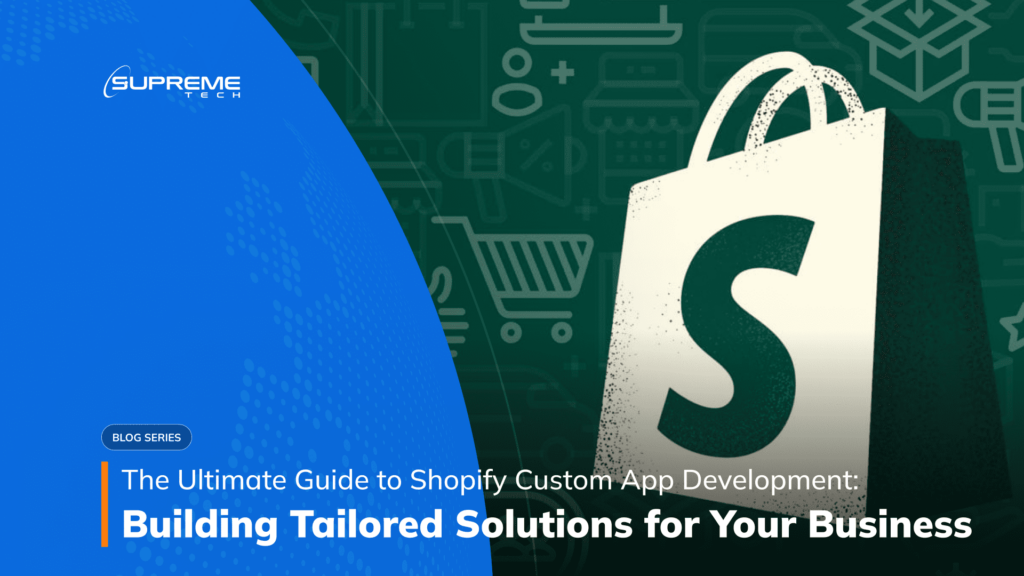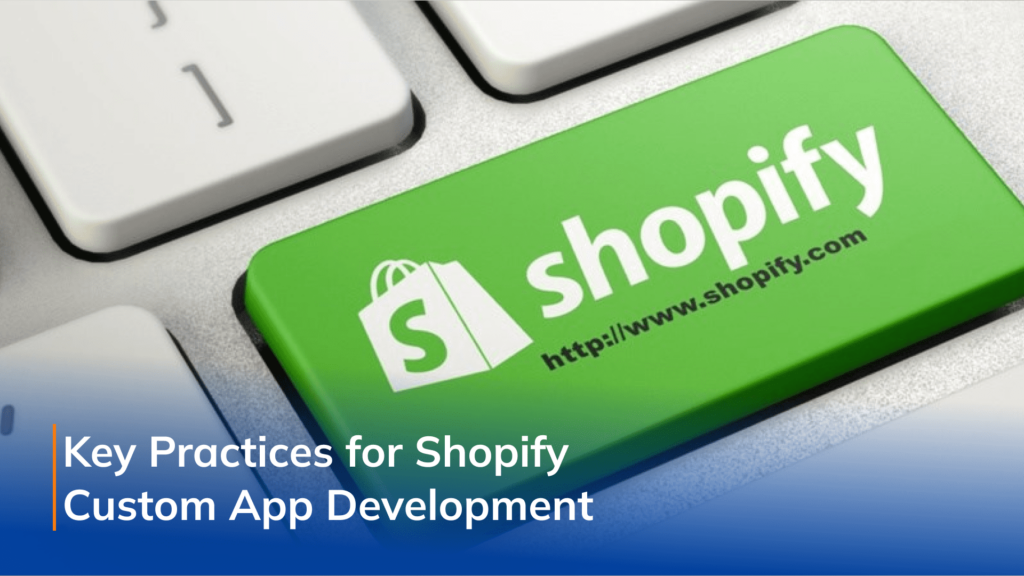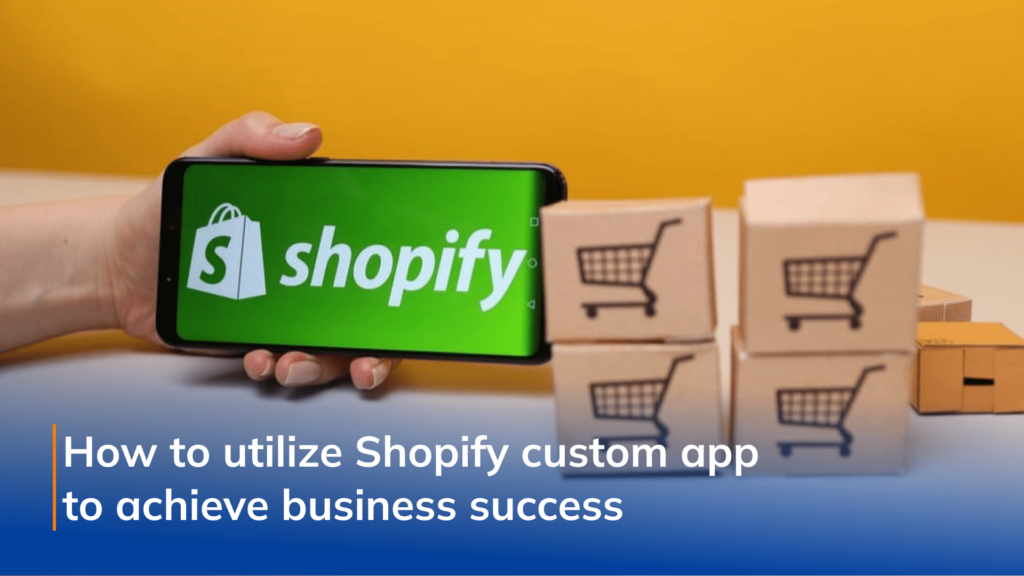The Ultimate Guide to Shopify Custom App Development: Building Tailored Solutions for Your Business
15/08/2023
1.03k
Table of Contents
Discover how custom apps can revolutionize your Shopify store, boost business efficiency, and enhance the customer experience. Explore key practices, expert tips, and real-world success stories that will equip Shopify store owners, B2B business owners, product owners, and e-commerce enthusiasts with the knowledge to find the perfect app solutions for their unique business models. Don’t miss this opportunity to stay ahead in the competitive e-commerce landscape with personalized and scalable Shopify custom apps that elevate your business to new heights.
Related articles:

What is Shopify Custom App Development?
Shopify Custom App Development provides businesses with personalized applications that integrate seamlessly with their stores. According to Shopify experts, it’s about “creating tailored solutions that precisely match business needs, offering a competitive edge” in the e-commerce market.
Benefits of Custom App Development for Shopify Stores
Experts affirm that custom apps offer “focused and efficient solutions, maximizing utility for businesses.” These apps also “enhance the user experience, driving customer satisfaction and loyalty” through personalized features like product recommendation engines and interactive interfaces.
How Custom Apps Enhance Business Efficiency
Custom apps automate tasks and integrate with existing systems, streamlining operations and boosting productivity. Shopify experts highlight that these apps “simplify reporting, enhance decision-making, and keep businesses agile in a rapidly evolving market.”
In summary, Shopify Custom App Development empowers businesses with tailored solutions, propelling them towards greater success in the competitive e-commerce landscape.
Key Practices for Shopify Custom App Development
Identifying Your Business Needs and Objectives
One of the crucial practices in Shopify Custom App Development is identifying your business needs and objectives. Before embarking on the app development journey, it’s essential to have a clear understanding of what you want the app to achieve. Whether it’s streamlining internal processes, improving customer engagement, or enhancing the user experience, defining your goals will guide the entire development process and ensure that the custom app aligns perfectly with your business objectives.

Choosing the Right App Development Partner
Selecting the right app development partner is a critical decision that can significantly impact the success of your custom app. Look for reputable developers or agencies with a proven track record in Shopify app development. Check their portfolios and client reviews to gauge their expertise and reliability. A capable app development partner will collaborate closely with you, offer valuable insights, and turn your vision into a reality. Communication and a shared understanding of your requirements are key factors in choosing the right partner for your Shopify custom app.
Designing User-Friendly and Intuitive Interfaces
A user-friendly and intuitive interface is paramount for the success of any custom app. When designing your Shopify custom app, prioritize simplicity and ease of use. Pay attention to navigation, layout, and visual design, ensuring that customers can intuitively interact with the app. A cluttered or confusing interface may deter users, leading to a subpar user experience. Through thoughtful interface design, you can provide a seamless and enjoyable experience for your app’s users, fostering engagement and customer satisfaction.
Ensuring Scalability and Flexibility
Scalability and flexibility are vital considerations in Shopify custom app development. As your business grows and evolves, your app should be able to accommodate increased traffic, new features, and changing requirements. A scalable app can handle higher user volumes without compromising performance, ensuring a smooth experience for all users. Additionally, a flexible app architecture allows for easy updates and modifications, enabling you to adapt to market trends and meet evolving customer demands.
Building Tailored Solutions: Customization and Integration
Seamless Integration with Existing Shopify Store Systems
A critical factor in building tailored solutions is seamless integration with existing Shopify store systems. The custom app should effortlessly work alongside other essential elements of the e-commerce store, such as the product catalog, inventory management, and payment gateways. By ensuring smooth integration, businesses can minimize disruptions to their existing workflows and optimize the overall user experience. A seamless integration approach also streamlines data flow between the app and the store, facilitating accurate reporting and analytics, and enabling businesses to make informed decisions based on real-time data.
Testing and Quality Assurance for App Reliability
As businesses build tailored solutions with custom apps, rigorous testing and quality assurance are paramount. Thoroughly testing the app’s functionalities, performance, and compatibility across different devices and browsers is crucial to ensure its reliability. By conducting comprehensive tests throughout the development process, businesses can identify and address potential issues before the app goes live. This approach guarantees that the custom app functions flawlessly, provides a positive user experience, and adheres to the highest quality standards.

Leveraging Shopify Custom App Development for Business Success
Enhancing Customer Experience and Engagement
Leveraging Shopify custom apps can significantly enhance the customer experience and drive higher engagement. By incorporating personalized features such as product recommendations, tailored promotions, and interactive elements, businesses can create a more immersive shopping experience for their customers. Personalization not only increases customer satisfaction but also fosters brand loyalty and repeat purchases. Shopify custom apps provide the tools needed to understand and cater to individual customer preferences, ultimately leading to improved customer retention and business success.
Increasing Sales and Conversions with Personalization
One key benefit of using Shopify custom apps is the ability to personalize the customer journey, which can lead to increased sales and conversions. Custom apps can track customer behavior, identify browsing patterns, and analyze past purchase history to deliver personalized product suggestions and promotions. Businesses can entice customers to make additional purchases by offering relevant and timely offers, increasing the average order value, and driving overall revenue. The tailored approach of custom apps can significantly impact the decision-making process, increasing the likelihood of completing a purchase.
Explore more: Streamline Your Operations With Shopify Order Management App
Tracking and Analyzing App Performance
To ensure continued success, it’s essential to track and analyze the performance of Shopify custom apps. Utilizing analytics and tracking tools allows businesses to gather valuable data on how customers interact with the app, which features are most effective, and where improvements can be made. Analyzing app performance provides valuable insights that can be used to optimize the app’s functionalities, enhance user experience, and make informed business decisions. By continuously monitoring app performance, businesses can stay proactive and responsive to changing customer needs and market trends.
Best Practices for Ongoing App Maintenance and Updates
Maintaining and updating Shopify custom apps is crucial to ensure they remain effective and secure. Regular app maintenance involves keeping the app up-to-date with the latest Shopify platform changes, bug fixes, and security patches. Moreover, businesses should actively seek customer feedback and insights to identify areas for improvement and new features. Staying proactive with app maintenance ensures that the app remains compatible with the latest devices and browsers, providing a seamless experience for all users. Ongoing updates also demonstrate the business’s commitment to delivering an exceptional user experience and can foster greater trust and loyalty among customers.
Shopify custom app development is a powerful tool for large-scale businesses
In conclusion, leveraging Shopify custom apps is a powerful strategy for businesses to achieve success in the e-commerce landscape. By enhancing customer experience and engagement, increasing sales and conversions through personalization, tracking and analyzing app performance, and following best practices for ongoing maintenance and updates, businesses can optimize their custom apps to drive business growth and achieve long-term success. Custom apps offer the flexibility and capabilities needed to stay competitive and deliver exceptional customer experiences in the ever-evolving world of e-commerce.
Let’s SupremeTech help you!
Learn more about our expertise in Shopify Plus custom app development through the latest case studies.
Contact us to get your tailored solution!
Related Blog





















